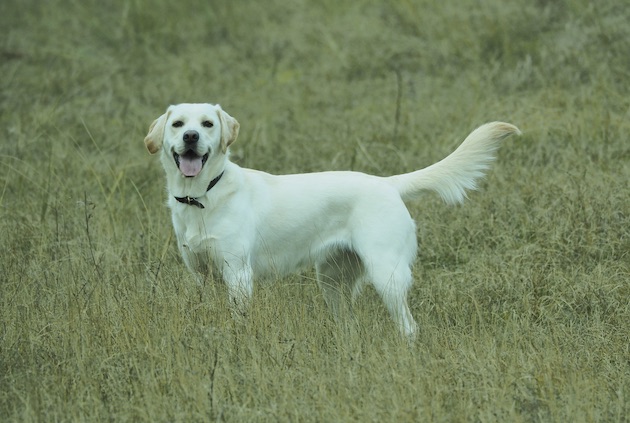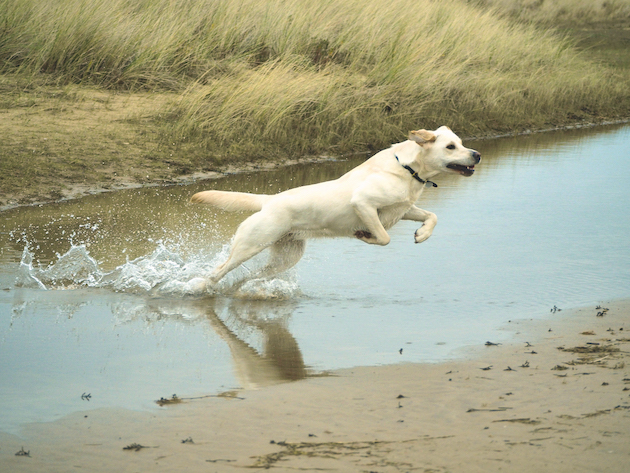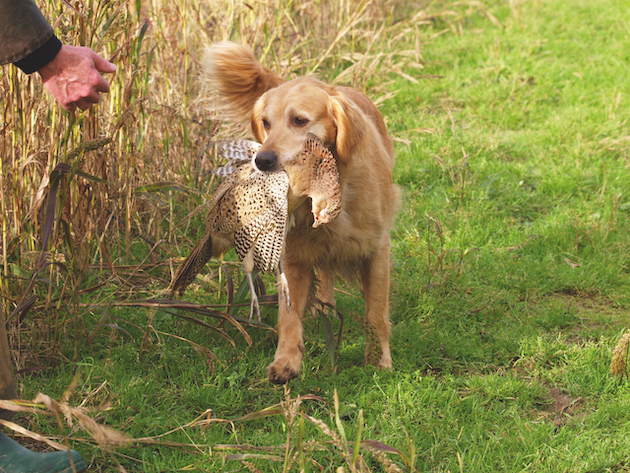Win CENS ProFlex DX5 earplugs worth £1,149 – enter here
Goldador: what happens when you cross a labrador with a golden retriever?
 Labrador x golden retriever. The plumed tail is the best indication of mixed breeding.
Labrador x golden retriever. The plumed tail is the best indication of mixed breeding.
We are all familiar with sprockers, cockapoos and labradoodles, but what do you call a cross between a labrador and a golden retriever? A golden labrador? (The name is a goldador.)
The ‘goldador’ cross
A ‘goldador’ cross between these two closely related breeds makes a lot of sense and has the potential to produce an outstanding gundog. (Read more about crossbreed gundogs here.)
It’s hardly a new cross, as the Guide Dogs charity has crossed the breeds for many years as part of its breeding programme, saying “the golden retriever crossed with the labrador has produced the most successful guide dog of all, combining many of the great traits of both breeds”.
From a working gundog perspective, there’s not a great deal of difference in the way a golden retriever works compared with a labrador. Enthusiasts will tell you that the former works on air scent far more than the latter, a trait that sometimes sees the breed marked down in trials when the judge, or judges, don’t appreciate that a dog with its head up may still be hunting as hard as one with its nose to the ground. From a practical point of view, it doesn’t make a great deal of difference to a dog’s performance.

Labrador x golden retriever.
Similar temperament
Though a friend owns a goldador retriever cross, a delightful dog that stays with me occasionally, it’s not a shooting dog and I’ve rarely seen such crosses in the shooting field, so I can’t comment on whether they work much differently than pure-bred examples of each breed. My guess is that they don’t. Physically, they are not easy to identify, as both breeds have remarkably similar conformation, so combining the two isn’t always obvious.
When it comes to temperament, there’s nothing between them. The Kennel Club’s breed standard for the labrador insists that dogs should be ‘intelligent, keen and biddable, with a strong will to please. Kindly nature, with no trace of aggression or undue shyness.’ For the golden retriever, it’s a much shorter: ‘Kindly, friendly and confident.’ Whether a typical golden is as keen to please as a labrador is debatable, but in my experience there’s not much to choose between them, while you may note the word kindly creeps into both descriptions.
There’s not a great deal of difference in the size and shape of the two breeds, either, at least if you exclude the heavy and ponderous show labradors. The labrador’s breed standard allows for dogs to be around 22in at the withers, while golden retrievers can go to 24in. Neither standard gives a desired weight. Both are described as being short-coupled, with deep, well-sprung ribs and a level topline. The coats of the two are obviously different, but both are expected to have a dense, water-resistant undercoat.

Golden retrievers were bred to retrieve
Inbreeding problems
If you delve into the history of the two breeds, it’s difficult to find much in the way of common ancestry, so one has to assume that their striking similarity in so many aspects is due to the fact that both were bred to do the same job, namely retrieving.
A combination of natural evolution and breeders trying to achieve the same thing has resulted in two very similar breeds, both of which should be able to do the same job of work equally well.
What, you might well ask, is the point of crossing the two and what is there to gain by such a move? The answer is simple: improved health. There’s not the space here to list the many inherited diseases that both breeds suffer from, but almost all have been caused by inbreeding.
The UK Kennel Club breed average COI (coefficient of inbreeding) for labradors is 6.5% and 9.4% for golden retrievers. Generally, the lower the COI, the better the health of a breed. A second indicator of breed health is the EPS (effective population size). For both, it’s 81.7. EPS is a measure of how many individuals are contributing genetically to a breed’s population and the size of the gene pool in a breed. Lower than 100 is usually considered critical, while below 50 brings a breed close to extinction.
Outbreeding — crossing one breed with another — is an effective way of introducing fresh blood and, at the same time, reducing the risk of inherited diseases. This is the main reason why Guide Dogs has routinely performed this cross.
A considerable amount of time and money is invested in a potential guide dog, so it’s essential that it’s as healthy as possible. Clearly, crossing two unhealthy dogs isn’t going to produce healthy puppies, even if they are different breeds.
However, by mating health-tested dogs — individuals clear of inherited diseases like epilepsy, hereditary cataract, entropion, and hip and elbow dysplasia — the chances of producing puppies that will grow up into strong, healthy, long-lived dogs are much higher.
There is one major downside: the Kennel Club refuses to allow cross-breeds to compete in any of its competitions. This hasn’t always been the case. A century ago, Charles Alington won the IGL Retriever Championship with ‘interbred’ dogs — Flashy in 1921 and Dazzle in 1922. Sadly, allowing cross-bred retrievers to compete once again is likely to be a step too far for the KC to consider.
Related Articles
Get the latest news delivered direct to your door
Subscribe to Shooting Times & Country
Discover the ultimate companion for field sports enthusiasts with Shooting Times & Country Magazine, the UK’s leading weekly publication that has been at the forefront of shooting culture since 1882. Subscribers gain access to expert tips, comprehensive gear reviews, seasonal advice and a vibrant community of like-minded shooters.
Save on shop price when you subscribe with weekly issues featuring in-depth articles on gundog training, exclusive member offers and access to the digital back issue library. A Shooting Times & Country subscription is more than a magazine, don’t just read about the countryside; immerse yourself in its most authoritative and engaging publication.







